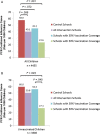School-located influenza vaccination decreases laboratory-confirmed influenza and improves school attendance
- PMID: 24829215
- PMCID: PMC4155443
- DOI: 10.1093/cid/ciu340
School-located influenza vaccination decreases laboratory-confirmed influenza and improves school attendance
Abstract
Background: School-located influenza vaccination (SLV) programs can efficiently immunize large numbers of school-aged children. We evaluated the impact of SLV on laboratory-confirmed influenza and absenteeism.
Methods: Active surveillance for influenza-like illness (ILI) was conducted on 4455 children in 4 SLV intervention and 4 control elementary schools (grades K-6) matched for sociodemographic characteristics during the 2010-2011 influenza season in Los Angeles County, California. Combined nose/throat swabs were collected from febrile children with ILI at presentation to the school nurse or during absenteeism.
Results: In SLV schools, 26.9%-46.6% of enrolled students received at least 1 dose of either inactivated or live attenuated influenza vaccine compared with 0.8%-4.3% in control schools. Polymerase chain reaction for respiratory viruses (PCR) was performed on 1021 specimens obtained from 898 children. Specimens were positive for influenza in 217 (21.3%), including 2009 H1N1 (30.9%), H3 (9.2%), and B (59.9%). Children attending SLV schools, regardless of vaccination status, were 30.8% (95% confidence interval, 10.1%-46.8%) less likely to acquire influenza compared with children at control schools. Unvaccinated children were indirectly protected in the school with nearly 50% vaccination coverage compared with control schools (influenza rate, 27.1 vs 60.0 per 1000 children; P = .023). Unvaccinated children missed more school days than vaccinated children (4.3 vs 2.8 days per 100 school days; P < .001).
Conclusions: Vaccination of at least a quarter of the school population resulted in decreased influenza rates and improved school attendance. Herd immunity for unvaccinated children may occur in schools with vaccination coverage approaching 50%.
Keywords: herd immunity; influenza; influenza vaccine; school-located influenza vaccination.
© The Author 2014. Published by Oxford University Press on behalf of the Infectious Diseases Society of America. All rights reserved. For Permissions, please e-mail: journals.permissions@oup.com.
Figures




Comment in
-
Editorial commentary: school-located influenza vaccination: why worth the effort?Clin Infect Dis. 2014 Aug 1;59(3):333-5. doi: 10.1093/cid/ciu344. Epub 2014 May 14. Clin Infect Dis. 2014. PMID: 24829211 No abstract available.
Similar articles
-
Influenza Vaccine is Protective Against Laboratory-confirmed Influenza in Obese Children.Pediatr Infect Dis J. 2016 Apr;35(4):440-5. doi: 10.1097/INF.0000000000001029. Pediatr Infect Dis J. 2016. PMID: 26658380 Free PMC article.
-
Evaluation of a city-wide school-located influenza vaccination program in Oakland, California, with respect to vaccination coverage, school absences, and laboratory-confirmed influenza: A matched cohort study.PLoS Med. 2020 Aug 18;17(8):e1003238. doi: 10.1371/journal.pmed.1003238. eCollection 2020 Aug. PLoS Med. 2020. PMID: 32810149 Free PMC article.
-
Cost effectiveness analysis of Year 2 of an elementary school-located influenza vaccination program-Results from a randomized controlled trial.BMC Health Serv Res. 2015 Nov 16;15:511. doi: 10.1186/s12913-015-1169-5. BMC Health Serv Res. 2015. PMID: 26573461 Free PMC article. Clinical Trial.
-
The impact of school-located influenza vaccination programs on student absenteeism: a review of the U.S. literature.J Sch Nurs. 2011 Feb;27(1):34-42. doi: 10.1177/1059840510389182. Epub 2010 Nov 15. J Sch Nurs. 2011. PMID: 21078842 Review.
-
Influenza vaccination of school teachers: A scoping review and an impact estimation.PLoS One. 2022 Aug 11;17(8):e0272332. doi: 10.1371/journal.pone.0272332. eCollection 2022. PLoS One. 2022. PMID: 35951517 Free PMC article.
Cited by
-
Influenza in the school-aged population in Mexico: burden of disease and cost-effectiveness of vaccination in children.BMC Infect Dis. 2020 Mar 20;20(1):240. doi: 10.1186/s12879-020-4948-5. BMC Infect Dis. 2020. PMID: 32197591 Free PMC article.
-
Technical guidelines for the application of seasonal influenza vaccine in China (2014-2015).Hum Vaccin Immunother. 2015;11(8):2077-101. doi: 10.1080/21645515.2015.1027470. Hum Vaccin Immunother. 2015. PMID: 26042462 Free PMC article.
-
Vaccination Programs for Endemic Infections: Modelling Real versus Apparent Impacts of Vaccine and Infection Characteristics.Sci Rep. 2015 Oct 20;5:15468. doi: 10.1038/srep15468. Sci Rep. 2015. PMID: 26482413 Free PMC article.
-
High Vaccination Coverage among Children during Influenza A(H1N1)pdm09 as a Potential Factor of Herd Immunity.Int J Environ Res Public Health. 2016 Oct 17;13(10):1017. doi: 10.3390/ijerph13101017. Int J Environ Res Public Health. 2016. PMID: 27763532 Free PMC article.
-
Severe acute respiratory illness surveillance for influenza in Kenya: Patient characteristics and lessons learnt.Influenza Other Respir Viruses. 2022 Jul;16(4):740-748. doi: 10.1111/irv.12979. Epub 2022 Mar 14. Influenza Other Respir Viruses. 2022. PMID: 35289078 Free PMC article.
References
-
- Glezen WP, Couch RB. Interpandemic influenza in the Houston area, 1974–76. N Engl J Med. 1978;298:587–92. - PubMed
-
- Medlock J, Galvani AP. Optimizing influenza vaccine distribution. Science. 2009;325:1705–8. - PubMed
-
- Frank AL, Taber LH, Wells CR, Wells JM, Glezen WP, Paredes A. Patterns of shedding of myxoviruses and paramyxoviruses in children. J Infect Dis. 1981;144:433–41. - PubMed
-
- Glezen WP, Couch RB, Taber LH, et al. Epidemiologic observations of influenza B virus infections in Houston, Texas, 1976–1977. Am J Epidemiol. 1980;111:13–22. - PubMed
Publication types
MeSH terms
Substances
Grants and funding
LinkOut - more resources
Full Text Sources
Other Literature Sources
Medical

